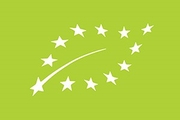Production system
Taking into account the environmental benefits of labels
Labeled products benefit from a bonus ranging from 10 to 20 points depending on the level of commitment and the estimated environmental benefits they represent. The level of benefit is determined on the basis of the scientific literature available to date: LCA, climate change indicators, phytosanitary treatments, eutrophication, impact on biodiversity, carbon storage in soils, impacts on deforestation, etc. (see sources).
Group 1 : +20 points
 Nature & Progrès — http://www.natureetprogres.org
Nature & Progrès — http://www.natureetprogres.org Bio Cohérence — http://www.biocoherence.fr
Bio Cohérence — http://www.biocoherence.fr Demeter — https://www.demeter.fr
Demeter — https://www.demeter.fr
Group 2 : +15 points
 AB Agriculture Biologique — http://www.agencebio.org
AB Agriculture Biologique — http://www.agencebio.org Technique de pêche durable¹
Technique de pêche durable¹
Group 3 : +10 points
 UTZ — https://utz.org
UTZ — https://utz.org Rainforest Alliance — https://www.rainforest-alliance.org
Rainforest Alliance — https://www.rainforest-alliance.org Fairtrade — http://www.fairtrade.net
Fairtrade — http://www.fairtrade.net Label Rouge — https://www.labelrouge.fr/
Label Rouge — https://www.labelrouge.fr/ ASC — http://www.asc-aqua.org
ASC — http://www.asc-aqua.org MSC — http://www.msc.org
MSC — http://www.msc.org
The Label Rouge bonus only applies to certain meats: beef, veal, lamb.
Sources
¹ Sustainable fishing techniques: line and hook, rod fishing, trap, shore fishing. These methods are selective and have no impact on the seabed and the habitat.
ADEME. (2020). Environmental labels. https://www.ademe.fr/labels-environnementaux
PUSH. (2020). Evaluation of food labels. https://www.labelinfo.ch/fr/projets-devaluation/-evaluation-des-labels-alimentaires
ITAB & INRA. (2016, novembre). Quantify and cost economically the externalities of organic farming ? http://itab.asso.fr/downloads/amenites/amenites-ab-synthese-nov2016.pdf
Réseau Action Climat & Fondation pour la Nature et l’Homme. (2010, septembre). Agriculture and greenhouse gases: state of the art and prospective. https://www.fondation-nicolas-hulot.org/wp-content/uploads/2020/10/101110_agriculture_et_gaz_a_effet_de_serre-etat_des_lieux_et_perspectives.pdf
Association Bleu-Blanc-Cœur. (2019, septembre). Assessment of the environmental impact of products in the Bleu-Blanc-Cœur sector by Life Cycle Analysis (LCA) - Methodological report.
WWF. (2019). Meat: eat less, eat better. https://www.wwf.fr/sites/default/files/doc-2020-11/MAJ202011_Etude_Viande-manger-moins-manger-mieux_WWF.pdf
France Stratégie. (2020, aout). The economic and environmental performance of agroecology. https://www.strategie.gouv.fr/sites/strategie.gouv.fr/files/atoms/files/fs-2020-na-94-agroecologie-aout.pdf
Last updated

